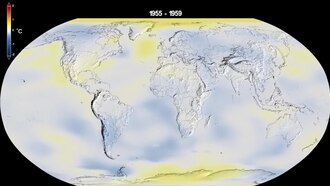Scientific consensus on climate change - Wikipedia.
Intergovernmental Panel on Climate Change (IPCC) 2007
In February 2007, the IPCC released a summary of the forthcoming
Fourth Assessment Report. According to this summary, the Fourth Assessment Report found that human actions are "very likely" the cause of global warming, meaning a 90% or greater probability. Global warming in this case was indicated by an increase of 0.75 degrees in average global temperatures over the last 100 years.
[35]
The
IPCC Fourth Assessment Report stated that:
- Warming of the climate system is unequivocal, as evidenced by increases in global average air and ocean temperatures, the widespread melting of snow and ice, and rising global average sea level.[36]
- Most of the global warming since the mid-20th century is very likely due to human activities.[37]
" style="position: relative; margin-right: auto; margin-left: auto; width: 330px;">
NASA time-lapse video: Global average temperatures have increased in evolving patterns in which cooler temperatures (shown in blues) have generally changed to warmer temperatures (shown in progressively intense reds).
- Benefits and costs of climate change for [human] society will vary widely by location and scale.[38] Some of the effects in temperate and polar regions will be positive, and others elsewhere will be negative.[38] Overall, net effects are more likely to be strongly negative with larger or more rapid warming.[38]
- The range of published evidence indicates that the net damage costs of climate change are likely to be significant and to increase over time.[39]
- The resilience of many ecosystems is likely to be exceeded this century by an unprecedented combination of climate change, associated disturbances (e.g. flooding, drought, wildfire, insects, ocean acidification), and other global change drivers (e.g. land-use change, pollution, fragmentation of natural systems, over-exploitation of resources).[40]
The New York Times reported that "the leading international network of climate scientists has concluded for the first time that global warming is 'unequivocal' and that human activity is the main driver, 'very likely' causing most of the rise in temperatures since 1950".
[41]
A retired journalist for
The New York Times, William K. Stevens wrote: "The Intergovernmental Panel on Climate Change said the likelihood was 90 percent to 99 percent that emissions of heat-trapping greenhouse gases like carbon dioxide, spewed from tailpipes and smokestacks, were the dominant cause of the observed warming of the last 50 years. In the panel's parlance, this level of certainty is labeled 'very likely'. Only rarely does scientific odds-making provide a more definite answer than that, at least in this branch of science, and it describes the endpoint, so far, of a progression.".
[42]
The
Associated Press summarized the position on sea level rise:
On sea levels, the report projects rises of 7 to 23 inches by the end of the century. An additional 3.9 to 7.8 inches are possible if recent, surprising melting of polar ice sheets continues.
[43]
U.S. Global Change Research Program
Main article:
United States Global Change Research Program

The
Fourth National Climate Assessment ("NCA4", USGCRP, 2017) includes charts
[44] illustrating how human factors, especially accumulation in the atmosphere of greenhouse gases, are the predominant cause of observed global warming.
Thirteen federal agencies, led by the
National Oceanic and Atmospheric Administration (NOAA), worked together under the auspices of the
United States Global Change Research Program (USGCRP) to prepare the country's
Fourth National Climate Assessment, published in two volumes as described below.
The
Climate Science Special Report: Fourth National Climate Assessment, Volume I (October 2017) provided the following summary:
This assessment concludes, based on extensive evidence, that it is extremely likely that human activities, especially emissions of greenhouse gases, are the dominant cause of the observed warming since the mid-20th century. For the warming over the last century, there is no convincing alternative explanation supported by the extent of the observational evidence.
Background
Formerly: Climate Change Science Program
The
U.S. Global Change Research Program reported in June 2009
[45] that:
Observations show that warming of the climate is unequivocal. The global warming observed over the past 50 years is due primarily to human-induced emissions of heat-trapping gases. These emissions come mainly from the burning of fossil fuels (coal, oil, and gas), with important contributions from the clearing of forests, agricultural practices, and other activities.
The 2009 report, which is about the effects that climate change is having in the United States, also said:
Climate-related changes have already been observed globally and in the United States. These include increases in air and water temperatures, reduced frost days, increased frequency and intensity of heavy downpours, a rise in sea level, and reduced snow cover, glaciers, permafrost, and sea ice. A longer ice-free period on lakes and rivers, lengthening of the growing season, and increased
water vapor in the atmosphere have also been observed. Over the past 30 years, temperatures have risen faster in winter than in any other season, with average winter temperatures in the Midwest and northern Great Plains increasing more than 7 °F (3.9 °C). Some of the changes have been faster than previous assessments had suggested.
Arctic Climate Impact Assessment
In 2004, the intergovernmental
Arctic Council and the non-governmental
International Arctic Science Committee released the synthesis report of the
Arctic Climate Impact Assessment:
[46]
Climate conditions in the past provide evidence that rising atmospheric carbon dioxide levels are associated with rising global temperatures. Human activities, primarily the burning of fossil fuels (coal, oil, and natural gas), and secondarily the clearing of land, have increased the concentration of carbon dioxide, methane, and other heat-trapping ("greenhouse") gases in the atmosphere...There is international scientific consensus that most of the warming observed over the last 50 years is attributable to human activities.
[47]
more to follow . . .



